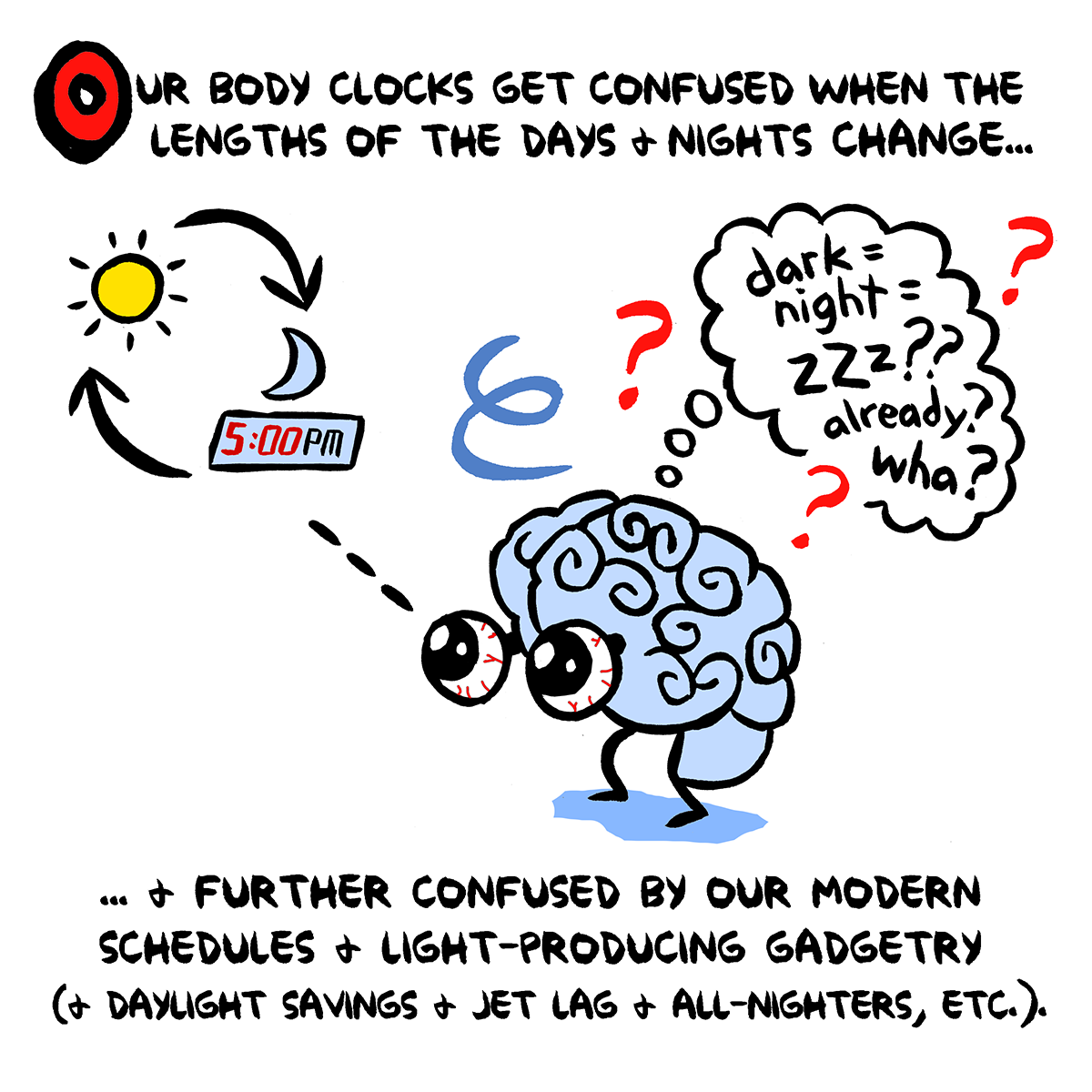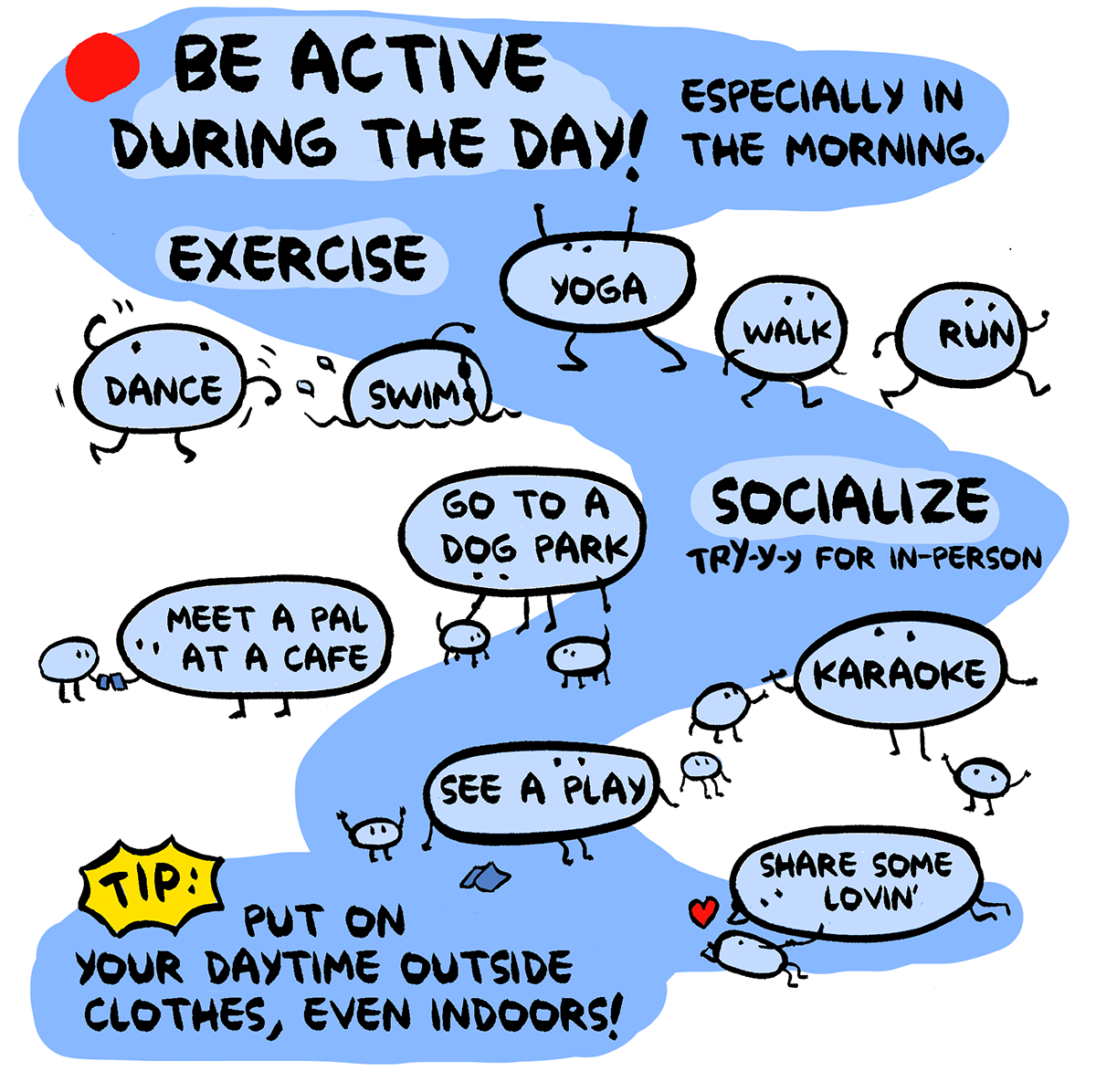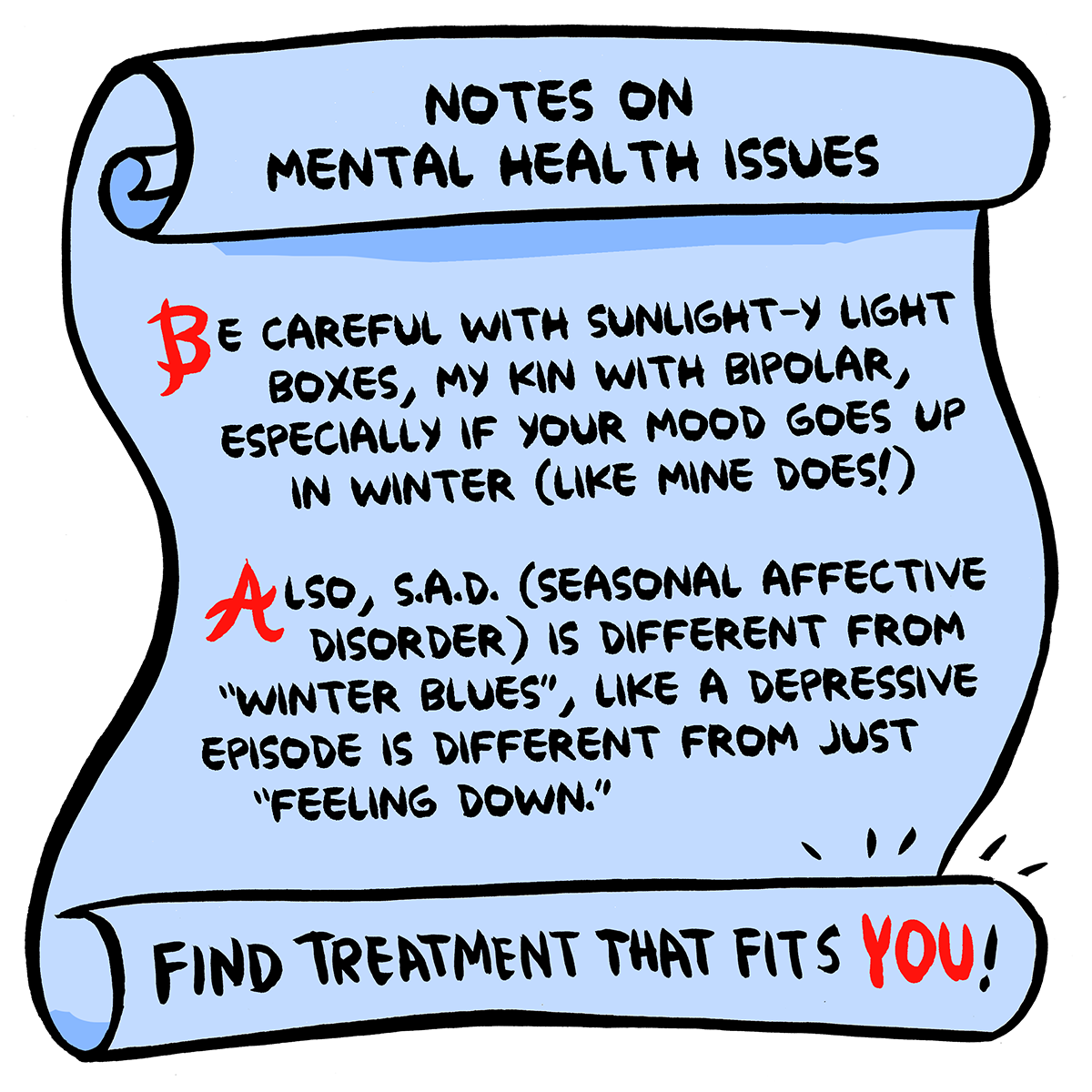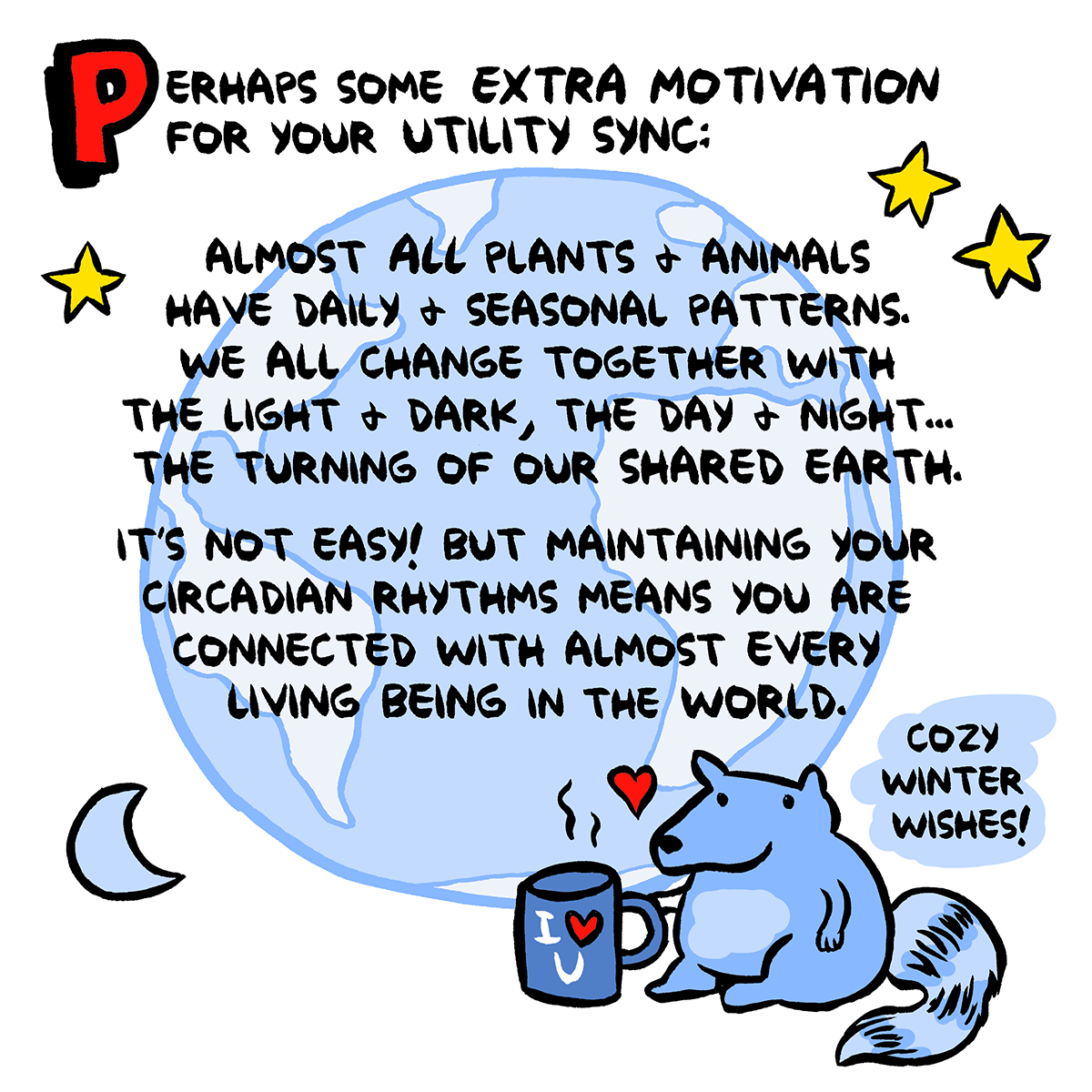Utility Sync!
Daylight saving has been saved! Sense of time, totally lost. Here's how to get your bearings again!
Our body’s daily routines, or circadian rhythms, get out of whack when the lengths of the days and nights change. Sleep gets turned upside down, but circadian rhythms aren’t just about sleep.
Most of our basic systems - digestion, body temperature, blood pressure, you name it - work on 24-hour cycles. They’re also sync’ed up together, like gears in a machine. (The human body! Amazing!) Those interlocking 24-hour cycles are regulated by the world’s most reliable, repeating, ongoing 24-hour event: the daily cycle of light and dark. So when that gets wonky, everything gets wonky!
Happens every year – so what’s going on, and what do we do?
Find balance in bipolar.
As a mental health coach with an action-oriented program, I will help you map out and manage your own long-term stability. I was diagnosed with Bipolar 1 in 1998, and have been stable for over 20 years. You—yes, you!—can have a stable life, too. Find more information at rocksteadycoach.com


Ellen Forney is an award-winning artist, author, and mental health coach. Her work includes bestselling graphic memoir, Marbles: Mania, Depression, Michelangelo, & Me, and mental health guidebook, Rock Steady: Brilliant Advice from My Bipolar Life, selected by JAMA (Journal of the American Medical Association) as “Best Graphic Medicine of 2018”. In addition to her popular TED talk, “Finding balance in bipolar”, her work has been published and reviewed in The Washington Post, Psychology Today, The Guardian, Bipolar Magazine, National Public Radio, and more.
Selected references and recommended reading, if yer interested!
“CME: Light Therapy: What, Why, for Whom, How, and When (And a Postscript about Darkness),” by Anna Wirz-Justice and Michael Terman, Praxis, Volume 111, Issue 2, Feb. 2022. (A dense but interesting article and study by a couple of Swiss researchers.)
Rhythms of Life: The Biological Clocks that Control the Lives of Every Living Thing, by Russell G. Foster and Leon Kreitzman, Yale University Press, 2004. (This is the book that got me fascinated with circadian rhythms!)
“The Best Light Therapy Lamp,” by Kit Dillon, Anna Perling, and Nancy Redd, Wirecutter, The New York Times, updated Oct. 13, 2022. (Wirecutter lists thoughtful reviews and recommendations for a wide variety of consumer products. You need a NYT subscription to look at more than a few for free, though, so choose carefully! :)
“The Best Sunrise Alarm Clock,” by Joanne Chen, Wirecutter, The New York Times, updated Feb. 4, 2021.
Transcript
Panel 1 - Intro text: The seasons, they go round and round, and the seasonal moods go up!! and down… Title: How to stay steady when the seasons keep changing!! Art: A person with a broken heart says to a tree that's shedding its leaves, “Don't ever change!” The tree responds, “Oh but I must.”
Panel 2 - Text: Circadian rhythms are our body processes that work together on a 24-hour cycle. Sleep is the best known 24-hour cycle, but it's only one of many! Art: Machine gears with a body process written in each gear: body temp, muscle strength, blood pressure, sleep, immune system, coordination, libido, appetite, the pooping, and much more.
Panel 3 - Text: These processes work best when they are sync’ed up, and we have a body clock that keeps them coordinated. Our body clock - the SCN (suprachiasmatic nucleus) is connected to our retinas, and uses dark and light to keep everything on time (light = day, dark = night). Art: A brain character is looking at the revolving sun and moon; an arrow points to the location of the SCN, behind the eyeballs. The brain character is thinking, “Light = day = action!”
Panel 4 - Text: Our body clocks get confused when the lengths of the days and nights change, and further confused by our modern schedules and light producing gadgetry and daylight savings and jet lag and all nighters, etc. Art: The brain character is looking at the revolving sun and moon, and a digital clock that says 5:00 PM. The character has bloodshot eyes, in a crouch stance, surrounded by question marks, thinking, “Dark = night = zZz?? Already? Wha?”
Panel 5 - Text: Here are some ways to balance your offbeat rhythms! Art: Brain character sitting at a drum kit, drumsticks flying willy nilly, thinking “Thank you!!” Text: Take note of your regular patterns. When do you eat, sleep, shower, frolic, chill? Art: Felix the Cat wall clock. Text: Stick to your regular schedule, or adapt it a bit (and stick to that)! Art: Gridded chart in a notebook..
Panel 6 - Get sunlight! (Actual or simulated.) “Chronotherapy” uses light and dark to help your body know when to wakke up and when to slow down. Morning walk. Art: Bird, whistling, walks holding a cup of to-go coffee. Text: These mimic morning light: Light box (best used for a few hours in the morning); Dawn simulator (optional audio: birds chirping or Mission Impossible theme).
Panel 7 - Text: Make your space brighter! Open your curtains! Turn on lights! Candles! Bright colors! Art: Window with open curtains, three lamps and a mirror ball, two tower candles, rainbow. Text: Also— Make your space dark at night! Getting good sleep at night is essential for being awake during the day! Art: two stars and “zZz”
Panel 8 - Text: Be active during the day! Especially in the morning. Exercise: dance, swim, yoga, walk, run. Socialize, and try for in-person: go to a dog park, meet a pal at a café, see a play, karaoke, share some lovin’. Tip: put on your daytime outside clothes, even indoors! Art: Blob characters with aforementioned activities written on them.
Panel 9: Text: Notes on mental health issues: Be careful with sunlight-y light boxes, my kin with bipolar, especially if your mood goes up in winter (like mine does!). Also, S.A.D. (seasonal affective disorder) is different from “winter blues”, like a depressive episode is different from just “feeling down”. Find treatment that fits YOU! Art: Scroll, with the text written on it.
Panel 10 - Text: perhaps some extra motivation for your utility sync: almost all plants and animals have daily and seasonal patterns. We all change together with the light and dark, the day and night… The turning of our shared Earth. It's not easy! But maintaining your circadian rhythm's means you are connected with almost every living being in the world. Cozy winter wishes! Art: Text is superimposed on a blue drawing of earth, with stars and moon. Small, smiling creature with a bushy tail holds a steaming beverage in a mug that says I <3 U on it.

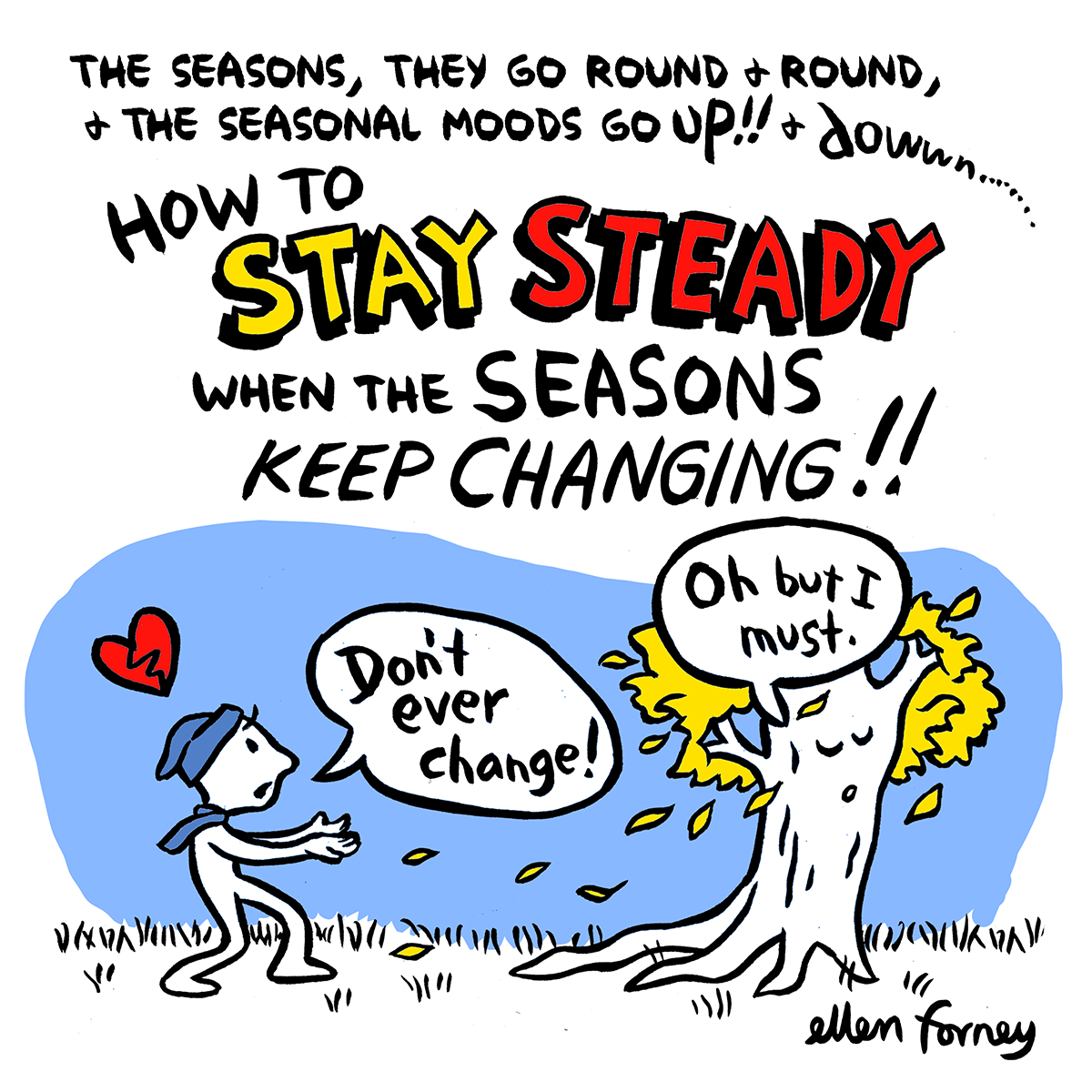
![Text: circadian rhythms are our body processes that work together on a 24 hour cycle. Sleep is the best known 24 hour cycle, but it's only one of many! Art: machine gears representing various body processes, e.g. immune system, appetite, [etc.]](https://images.squarespace-cdn.com/content/v1/634decbbdd286151e5052a7a/ac149fe2-0b58-47ca-8849-d0a4c922e373/CircRhythms_2.png)

